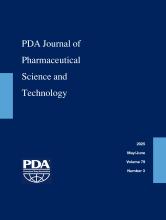Abstract
Given the surging interest in developing prefilled syringe and autoinjector combination products, investment in an early compatibility assessment is critical to prevent unwarranted drug/container closure interactions and avoid potential reformulation during late stages of drug development. In addition to the standard evaluation of drug stability, it is important to consider container closure functionality and overall device performance changes over time, due to drug-container closure component interaction. This study elucidates the mechanisms that cause changes in syringe glide force over time and its impact on the injection duration. It is an expansion of the previous work, which indicated that drug formulation variables such as formulation excipients and pH affect syringe functionality over time. The current study describes an investigative process for troubleshooting prolonged and variable autoinjector injection time caused by an increased syringe glide force variability over time. This increase in glide force variability stems from two root causes namely plunger dimensional variation and syringe silicone oil change over time. The results demonstrate (a) the underlying factors of silicone oil change in the presence of drug formulation matrices, (b) accelerated stability of syringe glide force as a good indicator of long-term, real-time stability, and (c) that buffer matrix filled syringes can be used to predict the syringe functionality and stability of drug product filled syringes. Based on the experimental findings of a variety of orthogonal characterization techniques including contact angle, interfacial tension and calculation of Hansen Solubility Parameters, it is proposed that silicone oil change is caused by formulation excipients and a complex set of phenomena summarized as ″wet, wash, and de-lube″ processes.
- Received February 21, 2020.
- Accepted July 13, 2020.
- Copyright © 2020, Parenteral Drug Association
PDA members receive access to all articles published in the current year and previous volume year. Institutional subscribers received access to all content. Log in below to receive access to this article if you are either of these.
If you are neither or you are a PDA member trying to access an article outside of your membership license, then you must purchase access to this article (below). If you do not have a username or password for JPST, you will be required to create an account prior to purchasing.
Full issue PDFs are for PDA members only.
Note to pda.org users
The PDA and PDA bookstore websites (www.pda.org and www.pda.org/bookstore) are separate websites from the PDA JPST website. When you first join PDA, your initial UserID and Password are sent to HighWirePress to create your PDA JPST account. Subsequent UserrID and Password changes required at the PDA websites will not pass on to PDA JPST and vice versa. If you forget your PDA JPST UserID and/or Password, you can request help to retrieve UserID and reset Password below.






